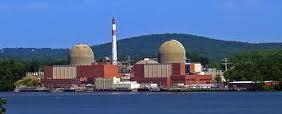Nuclear powerNuclear energy facilities proved themselves resilience during Hurricane Sandy
There are thirty-four nuclear energy facilities in the area hit by Hurricane Sandy; all of them have responded well and safely to the powerful storm; the industry says that careful planning and preparations days in advance of the storm paid off at all of these facilities

New York's Indian Point nuclear plant // Source: wikipedia.org
There are thirty-four nuclear energy facilities in the area hit by Hurricane Sandy. The Nuclear Energy Institute (NEI), and industry association, said that all of them have responded well and safely to the powerful storm.
NEI says that careful planning and preparations days in advance of the storm paid off at all of these facilities, which were prepared to take the steps necessary to maintain safety against high winds, record flooding, and disturbances on the regional electric grid. Trained reactor operators and emergency response personnel stationed at the plants during the storm were able to take actions beyond their usual duties to protect the power plants and communities that surround them. As Hurricane Sandy moves beyond the mid-Atlantic and Northeastern states after knocking out electricity to seven million customers in thirteen states, nuclear facility operators have been conducting inspections to ensure that all systems and equipment are ready to maintain the facilities in a safe condition.
Of the thirty-four nuclear facilities from South Carolina to Vermont in Hurricane Sandy’s path, twenty-four continued to operate safely and generate electricity throughout the event. Seven were already shut down for refueling or inspection, and three in New Jersey or New York safely shut down, as designed, because of storm conditions or grid disturbances. Inspectors from the U.S. Nuclear Regulatory Commission (NRC) have been stationed at each nuclear energy facility to oversee preparation for and recovery from the storm.
“Hurricane Sandy once again demonstrates the robust construction of nuclear energy facilities, which are built to withstand extreme flooding and hurricane-force winds that are beyond that historically reported for each area,” said Marvin Fertel, president and chief executive officer at NEI. “Beyond the physical strength of these nuclear power plants, the professional crews that operate and maintain them take exacting precautions as significant storms approach. They also coordinate with local, state and federal emergency response officials.
“Our facilities’ ability to weather the strongest Atlantic tropical storm on record is due to rigorous precautions taken in advance of the storm. In the days prior to Sandy storming the Atlantic coast, nuclear plant operators took a series of actions outlined in their emergency preparedness plans,” Fertel said. “These include securing or moving any equipment that could possibly become airborne due to high winds and verifying that weather-tight doors and water intakes are prepared. Each plant site also has numerous emergency backup diesel generators that are tested and ready to provide electricity for critical operations if electric power from the grid is lost.”
NEI says that as a precaution, a reactor will be shut down at least two hours before the onset of hurricane-force winds at the site, typically between 70 and 75 miles per hour. If there is a loss of off-site power during or following a hurricane, reactors automatically shut down as a precaution and the emergency backup diesel generators will begin operating to provide electrical power to plant safety systems.
“Actions taken by companies operating reactors in the mid-Atlantic and Northeast once again demonstrate that nuclear energy facilities are well protected against extreme natural events,” Fertel said.
In 2011, twenty-four reactors at fifteen facilities from North Carolina to New England safely withstood Hurricane Irene, a category 3 hurricane. In 2005, Entergy safely shut down Waterford 3 in Louisiana after Hurricane Katrina, a category 5 hurricane, knocked out off-site power and damaged the regional electrical infrastructure. Florida Power & Light in 2004 safely shut down St. Lucie 1 and 2 in Florida after Hurricane Jeanne caused a loss of off-site power.
During Hurricane Sandy, Exelon Corp.’s Oyster Creek reactor in New Jersey, which was shut down before the storm for a refueling outage, declared an alert on 29 October. The alert, the second lowest of four Nuclear Regulatory Commission action levels, was in response to high water levels at the facility’s cooling water intake structure. Exelon is in the process of restoring off-site power to the facility. Until then, Oyster Creek is being safely powered by backup diesel-driven electrical generators that have fuel to power the reactor’s safety systems for more than two weeks. The plant’s reactor and used fuel storage pool have ample water supplies for cooling.
The NEI notes that nuclear power plants operating in thirty-one states provide electricity to one of every five U.S. homes and businesses. Nuclear energy produces more electricity than any other source in Connecticut, Illinois, New Hampshire, New Jersey, South Carolina, Vermont, and Virginia.
The institute says that nuclear energy facilities are designed to withstand natural occurrences greater than those encountered in the regions where they are located. They are built to withstand floods, earthquakes, and high winds, and have numerous safety systems that will operate and safely shut the reactor down in the event of a loss of off-site power.
